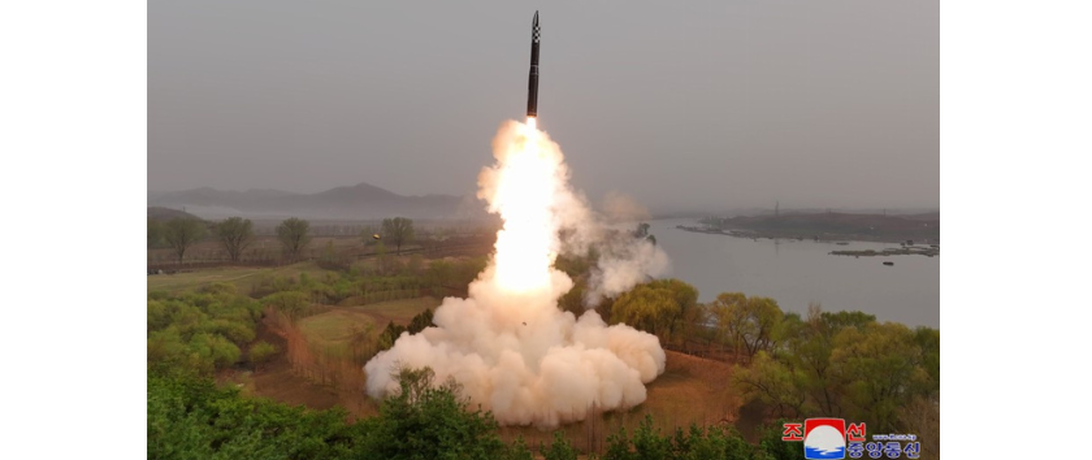
Key Takeaways
-
On 13 April 2023, the Democratic People's Republic of Korea (DPRK) conducted its first flight test of a solid-propellant intercontinental ballistic missile (ICBM), the Hwasong-18. [1]
-
This test was conducted in a highly unusual way, causing Japan to issue a missile alert.
-
Solid-propellant ICBMs could represent an increased threat to the continental United States.
-
The DPRK is likely to test-fire the Hwasong-18 again in the future to demonstrate its full capabilities.
Summary of the Launch
The DPRK test launched its first solid-propellant ICBM, the Hwasong-18, on 13 April 2023. Compared with liquid-propellant land-mobile ICBMs of the DPRK, solid-propellant ICBMs are operationally easier to maintain as they have fewer mechanical parts, have a shorter launch preparation time by possibly several hours as they do not need to be fueled before launch, and are more compatible to different road conditions. These advantages may potentially reduce the chance of being detected before launch, thus a solid-propellant ICBM fleet could represent an increased threat to the continental United States.
Missile Layout and Flight Path
The Hwasong-18 has a typical layout for a solid-propellant ICBM: it has three stages and a payload fairing to reduce air drag (Figure 1). [2]
Figure 1. The Hwasong-18 has a typical solid-propellant ICBM layout similar to that of the Topol-M and the Minuteman III. Images: KCNA [3], RussianSpaceWeb [4], US DoD [5]
According to DPRK State media, the Hwasong-18 followed a standard trajectory optimized for reaching maximum range during its first stage burn, but pulled itself up to fly a highly-lofted trajectory during its second and third stage burn. This highly unusual flight profile likely caused Japan to issue a missile alarm, [6] as during the first stage burn it would appear that the missile could overfly Japan.
The State media report states that this flight profile was chosen "in consideration of the security of the neighboring countries and the safety of the multi-stage-separation of the missile during its flight in the territorial air." [7] Adopting such a flight path for test flights, however, could increase the risk of miscalculation, as it is more difficult to estimate the full trajectory upon launch.
State media also reported that the ICBM restricted its velocity with "delayed stage separation," which most likely means that the missile coasted in space with the burnout stage before discarding this deadweight and the ignition of the next stage. If the claim about "delayed stage separation" is true, it would also suggest that the DPRK has successfully developed techniques for unpowered coasting, a mechanism frequently used in satellite launches. Thus, the test may also have served to verify technologies for use in future satellite launches.
Yonhap News Agency reported that the missile travelled 1,000 km and reached a ceiling of below 3,000 km before landing in the East Sea/Sea of Japan. [8] Due to the unpowered coasting phase and the change in flight direction, it is difficult to assess the missile's potential range. To date, for each of the DPRK's liquid-propellant ICBMs there have been at least two flight tests; thus, the DPRK is likely to test fire the Hwasong-18 again in the future to fully demonstrate its capabilities.
Better Off-Road Capability
The Hwasong-18 was launched from a patch of grassland in Pyongyang (Figure 2). The launch from a non-concrete surface indicates that the Hwasong-18 has better off-road capability than the State's large liquid-propellant, land-mobile ICBMs, namely the Hwasong-15 and Hwasong-17, which have been transported on and launched from hardened surfaces.

Figure 2. Launch of the Hwasong-18. Image: KCNA. [9]
DPRK's 5-Year Plan
The Hwasong-18 launch again demonstrates the effort of the DPRK’s defence industry to complete the tasks ordered by Kim Jong Un. Land- and sea-based solid-propellant ballistic missiles with intercontinental range appear to be one of the five core tasks of the five-year plan (2021-2025), set forth during the 8th Congress of the Workers' Party of Korea. [10] With the launch of the Hwasong-18, progress has been made in four out of the five tasks, namely (1) producing tactical nuclear warheads and large, high-yield nuclear warheads; (2) raising strategic striking distance up to 15,000 km; (3) developing and deploying hypersonic glide vehicles within a short time; and (4) developing ground- and sea-based solid-propellant ballistic missiles of intercontinental range. The only task remaining without visible progress would be "possessing nuclear-powered submarines and an underwater-launched nuclear strategic weapon."
[1] Also referred to as “Hwasongpho-18” by DPRK State media.
[2] For more information and initial measurement of the Hwasong-18, see: Tianran Xu, Brief on the DPRK’s 8 February 2023 Parade, ONN, 23 February 2023, available at: https://opennuclear.org/publication/brief-dprks-8-february-2023-parade
[3] Another Mighty Entity Showing Continuous Development of Strategic Force Unveiled in DPRK, KCNA, 14 April 2023, available at: http://kcna.kp/en/article/q/1764e4431f2d91ad94dd8be97a2f8760.kcmsf
[4] Topol-M, Russian Space Web, available at: https://www.russianspaceweb.com/topolm.html
[5] Jim Garamone, Austin Postpones Test of Minuteman III Missile, 2 March 2022, available at: https://www.defense.gov/News/News-Stories/Article/Article/2952925/austin-postpones-test-of-minuteman-iii-missile/
[6] Shaimaa Khalil, Jean Mackenzie and Kelly Ng, North Korea missile launch sparks confusion in Japan, BBC, 13 April 2023, available at: https://www.bbc.com/news/world-asia-65259718
[7] Another Mighty Entity Showing Continuous Development of Strategic Force Unveiled in DPRK, KCNA, 14 April 2023, available at: http://kcna.kp/en/article/q/1764e4431f2d91ad94dd8be97a2f8760.kcmsf
[8] 북, '은밀성 높은' 고체ICBM 시험에 무게…3축체계 무력화 우려 [North Korea likely test fired a highly stealthy solid-fuel ICBM; concerns that it neutralizes the triad system], Yonhap News Agency, 13 April 2023, available at: https://www.yna.co.kr/view/AKR20230413083751504?input=tw
[9] Another Mighty Entity Showing Continuous Development of Strategic Force Unveiled in DPRK, KCNA, 14 April 2023, available at: http://kcna.kp/en/article/q/1764e4431f2d91ad94dd8be97a2f8760.kcmsf
[10] The exact five tasks were not clearly stated. For an interpretation of what these tasks are, see: Tianran Xu, Emerging Capabilities? The Unflown SLBMs of the DPRK, ONN, 25 July 2022, available at: https://opennuclear.org/publication/emerging-capabilities-unflown-slbms-dprk